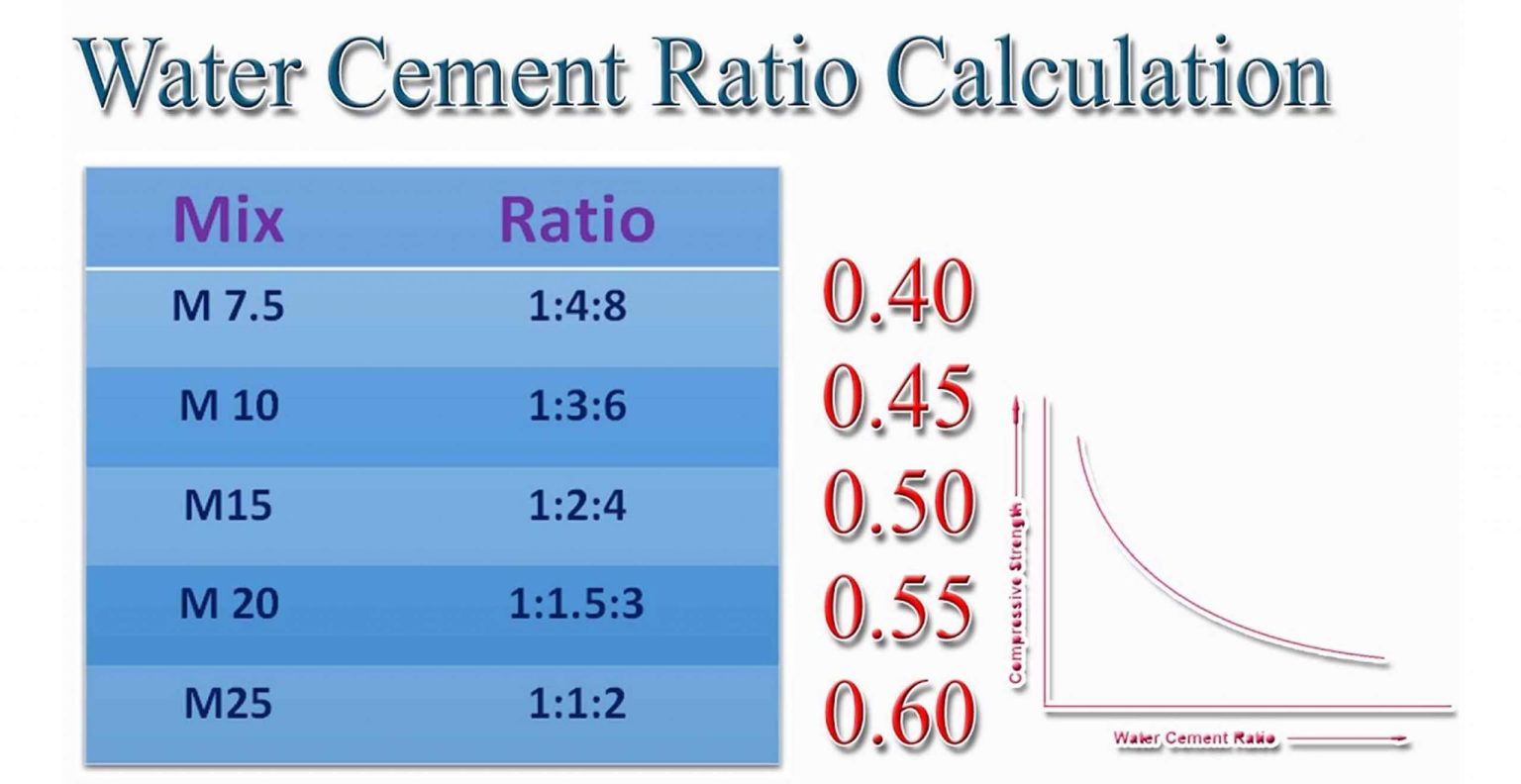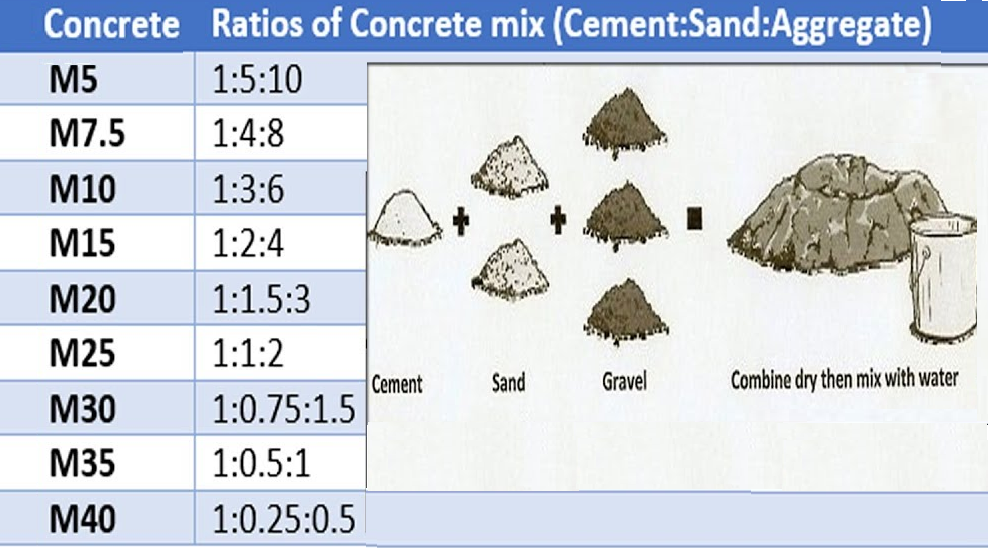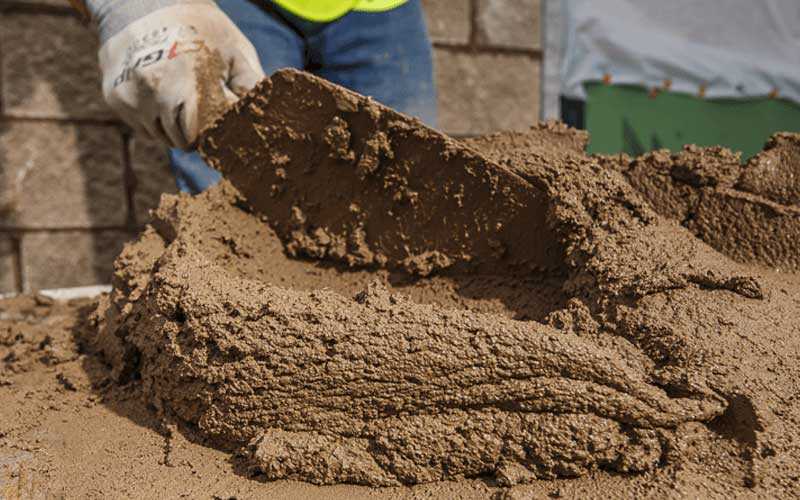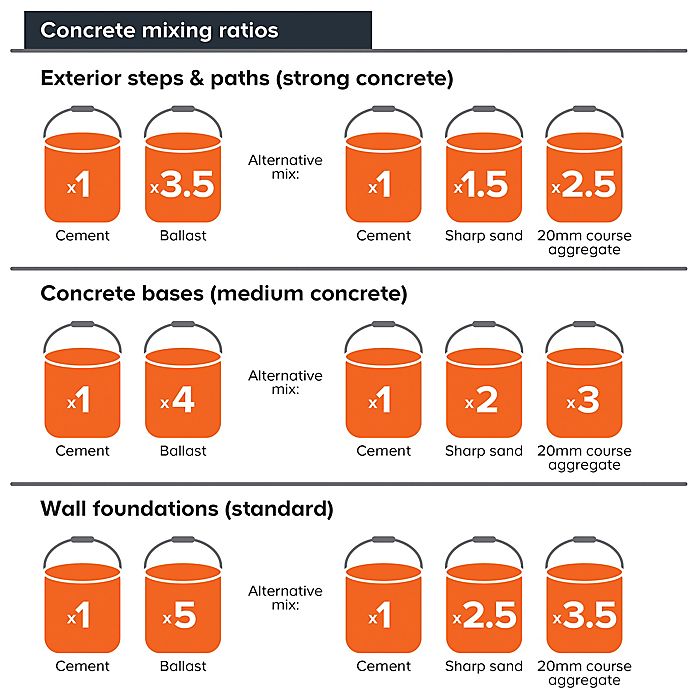
Water Cement Ratio Calculation Engineering Discoveries
1 Blend the Dry Mortar Mix Choose whether to use a mortar mix, or make your own mortar from scratch using Portland cement, fine masonry sand and clean tap water. For larger jobs that might require multiple mortar batches, using a mortar mix may can ensure that the mortar has a consistent strength and appearance.
ArchiDesigners CALCULATION OF CEMENT AND SAND QUANTITY IN MORTAR
Explanation of mortar mix ratio notation . The first digit, or first two digits of a mix proportion refer to the binder content (i.e. lime or cement or both) and the last digit always refers to the filler, which is usually sand. So a 1:3 mix could mean 1 part by volume of cement to 3

What is the strongest concrete mix ratio?
This means of 1 kg mortar, 0.4 part is water, 1 part is cement and 3 parts are sand. 1 part = 1 kg / ( 0.4 + 1 + 3) This gives, 1 part = 0.227 Quantities of different constituents are, water = 0.4 * 1 part =0.4 * 0.227 kg = 0.09 kg Cement = 1 part = 0.227 kg Sand = 3* 1 part = 0.683 kg
:max_bytes(150000):strip_icc()/recommended-guide-for-selection-of-mortar-mix-type-844821-new-da021ac214d74f659a3959e812a65eab.png)
How to Choose the Right Mortar Mix Type N, O, S, or M
The standard ratio for average mortar mix is 3:1 or 4:1 for bricklaying. If you are using a pointing mix, then you should have a ratio of 1:4 or 1:5 mortar to sand. As for concrete, it depends on the strength you need it to be at. Usually, it is good practice to mix concrete at 1:2 mix to materials.

Masonry Cement and Sand Mortar (M,S,N) SPEC MIX
= (1.3×1)/7 = 0.185 m 3 Since the cement is available in bags, volume of 1 cement bag (50kg) is 0.0347 m 3. 0.185 m 3 = (1.3×1)/ (7×0.0347) = 5.35 bags Quantity of sand Volume of sand is = Volume of dry mortar x (Parts of sand / Total parts of ingredient) = (1.3×6)/7=1.14 m 3 of sand or fine aggregate Quantity of Water

Mortar mix ratios and types of mortar (2023)
The mortar has to contain enough sand or aggregate to hold up to the wall's weight, as pure cement with water cannot hold up. The perfect combination of sand and cement creates a mortar that is both strong as well as thick. Advertisement

Cement, mortar and concrete buying guide Ideas & Advice DIY at B&Q
A typical mortar mix ratio is 1 cement : 3 sand. But what is the water ratio? Is it 0.5:1:3? Would a 0.5:1:2 ratio be a stronger mortar? Our next door neighbor has a dog that digs like a pro. The dog somehow manages to dig underneath some parts of our wire fence netting and get through. So I have thought of filling the holes with mortar.

Lime Cement Plaster Recipe Dandk Organizer
The standard mix for wall pointing is 5 parts sand, 1 part cement, and 1 part lime. This mortar mix ratio creates a type N mortar with a strength of 750 psi. If you need more strength, add more cement and sand. At 8 parts sand, 2 parts cement and 1 part lime you create a type S mortar with 1800 psi.

How to Determine Correct Ratio of Sand to Cement When Making Mortar Makao Bora
Should you need to make type K mortar, it can be made by combing 1 part cement, 3 parts lime, and between 10 to 12 parts sand. Type N Type N is the most common mortar mix ratio used on professional and amateur jobsites today.

What Is The Mixing Ratio For Plaster beyoglumirza
Mortar material is made with Portland cement, hydrated lime, and sand combined in specific proportions to meet required specifications. Thinset mortar is a moisture-resistant adhesive made of Portland cement, water, and fine sand, which is used with projects involving cement board, shower tile, backsplashes, and shower pans. Type N Mortar Mix
:max_bytes(150000):strip_icc()/Laying-brick-in-the-wall-1259649332_56-56b756305f9b5829f83867ed.jpg)
How to Choose the Right Mortar Mix N, O, S, or M
Mortar mix ratio i.e. proportioning of cement sand in mortar provides consistency in the performance and appearance of masonry construction. Proper proportioning of mortar ingredients helps in having the following advantages: Uniformity of strength Uniform workability Uniform color Uniformity of proportions and yields

5 Different Grades Of Cement Mortar Ratio & Uses
Divide the total volume by the sum of the parts in your chosen mix ratio (e.g., 5 for a 4:1 mix) to determine the volume of each part. Multiply the volume of each part by the individual sand and cement proportions (e.g., 4 parts sand and 1 part cement for a 4:1 mix) to find the total volumes of sand and cement required.

MORTAR MIX RATIO FOR WALL PLASTERING & BRICKWORK Civil Engineering Panel
Cement to sand ratio for plastering The typical cement sand mortar ratio for plastering a brick wall in a typical residential home is (cement:sand) 1:4 and 1:6. Typical exterior plaster requires a 1:4 mortar ratio and interior plaster requires a 1:6 mortar ratio.

Pin on Civil Engineer Things
Damaged bricks are far more difficult to replace. With that rule in mind, I generally use these ratios: Hard bricks: 4 building sand to 1 cement with plasticizer. Soft bricks: 5 building sand to 1 cement with plasticizer. Very soft bricks: 6 building sand to 1 cement with plasticizer. Period bricks: Replace the cement with hydraulic lime.

How To Calculate Quantity Of Cement, Sand And Water In Mortar Of 14 Engineering Discoveries
Just follow these simple steps: Enter the number of parts of cement you plan to use in the "Parts Cement" field. Next, enter the number of parts of sand you'll be using in the "Parts Sand" field. Click the "Calculate" button. The calculator will instantly display the Cement to Sand Ratio (CSR) you need for your construction project. Formula

quantity of cement sand in mortar cement sand ratio for brick wall Civil Field Engineer
There are a variety of mortar mixes that the mason contractor can mix up, depending on the type of material that is being installed: Type M (2500 psi) Type S (1800 psi) Type N (750 psi) The different types are achieved by varying the ratio of Portland Cement, Lime and Sand. Type S mortar is the most common for the Arizona market so we will use.